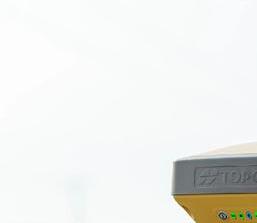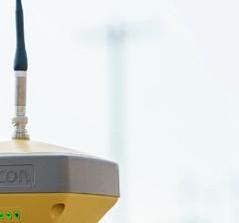








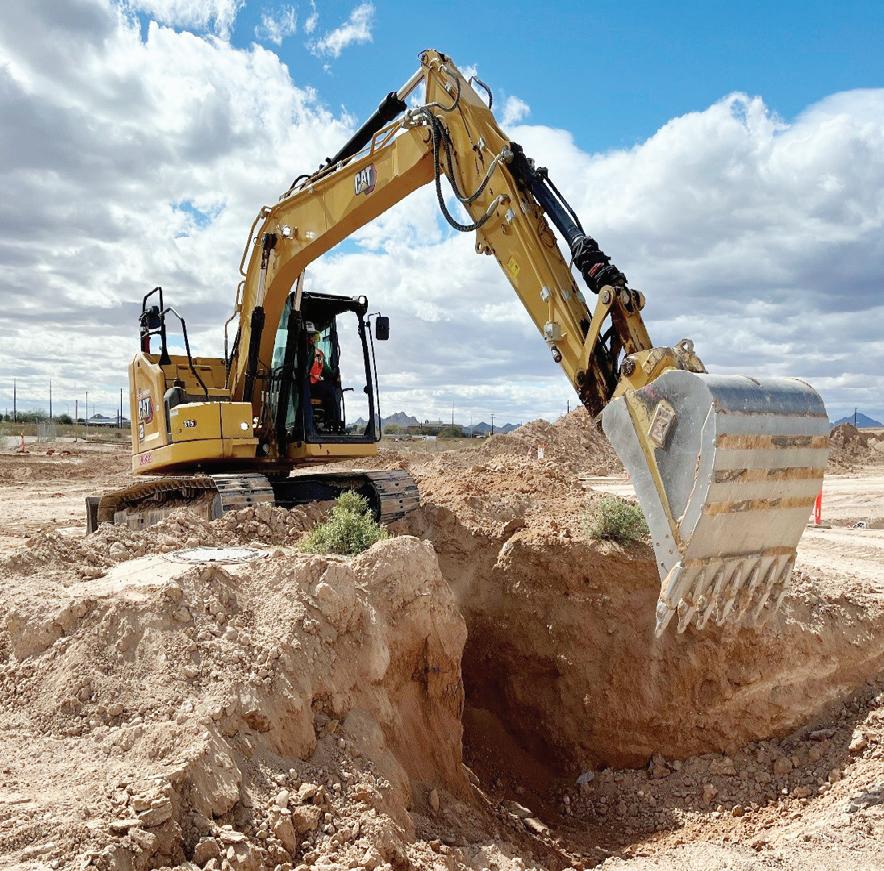
By Lorie Jewell CEG CORRESPONDENT
A full cadre of construction vehicles — excavators, dozers, scrapers, loaders, and more — is tangible evidence that development of the $425 million Mosaic Quarter sporting and entertainment complex is well under way on Tucson, Ariz.’s southside.
California-based subcontractor Granite Construction has a $27 million contract for the first phase of the privately funded project. When complete, it will feature a 175,000-sq.-ft. iceplex with three rinks and an arena seating 3,000; a 131,000-sq.-ft. fieldhouse; a central utility plant; and solar power for the complex.
General contractor Hensel Phelps is heading up the construction.
Work began in November 2024 with a daily crew of 25 craft and underground workers; during paving operations, there are 12 additional crew members, said Zach Thompson, Granite area manager. Much of the current work is focused on the underground sewer system, he added. The phase is scheduled to be finished in August 2026.
“The project is in great shape and running on schedule,” Thompson said. “The challenge is making sure of the safety of the underground crews” while constructing a 30-ft.-deep sewer, setting 96-in. polymer concrete manholes, laying pipes and placing the shoring.
Specifically, the project is coming together with 32,000 tons of aggregate base and 20,000 tons of asphalt for roads and parking lots, along with 14,000 tons of sand for utility beds, shading and backfill. The materials come from Granite’s nearby Swan Plant.
Crews will install 8-ft. stormwater pretreatment units; C900, HDPE, RCP, and SDR35 piping; Nyloplast drain basins; shoring devices; and 10ft. by 40-ft. steel reinforced HDPE cisterns, Thompson said.
All of this is being installed and completed with an extensive lineup of construction equipment, featuring a mulcher, three water trucks, two regular-size excavators and a mini, two loaders, three scrapers, a telehandler, three graders, two dozers, a tractor, backhoe and compactor.
Pima County granted a 40-year lease for the 90-acre site last year to Knott Development, in conjunction with Mosaic Quarter Development.
Officials project the complex, adjacent to Kino Sports Complex off north Interstate 10, will generate as much as $917.7 million in tax revenue and up to $8.3 billion of new local expenditures.
MOSAIC page 7

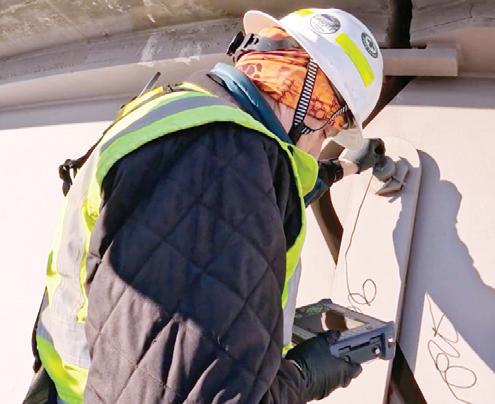
Utah Department of Transportation (UDOT) crews recently inspected one of Salt Lake’s “Spaghetti Bowl” bridges with ultrasonic testing.
This technology uses a transducer to transmit high-frequency sound waves into difficult-to-see parts of a bridge, searching for damage, deterioration or any other factors that may raise safety concerns. The bridge, built in 1985, connects northbound Interstate 215 to westbound Interstate 80.
“Ultrasonic testing is one of the many tools we use when assessing the condition of bridges,” UDOT Bridge Management engineer Becky Nix said.
Although not part of the standard inspection process, Nix said ultrasonic testing is used in specialty situations to evaluate critical bridge elements.
“We want everyone to know that when they are driving on one of our bridges, they are going to be safe,” Nix said.
The typical bridge inspection process involves detailed data collection, including written and photo documentation, and ranking scales. Nix said that, occasionally, inspection crews use ultrasonic testing, LiDAR (eye-safe laser beams), ground penetrating radar or infrared thermography to gather data on a bridge’s condition.
All inspection standards are set and evaluated by the American Association of State Highway and Transportation Officials (AASHTO) and the Federal Highway Administration (FHWA). UDOT bridge inspection crews use these standards to perform biennial inspections of more than 3,000 state and locally owned bridges.
“We complete 150-160 bridge inspections per month,” Nix said. “It’s a busy schedule but this data is so valuable. They help to ensure public safety and help prioritize future projects. We’re constantly collecting data so that we can make smarter, safer decisions for the state’s infrastructure.”
For example, data from the January inspection of the Veyo Arch bridge on State Route 18 identified critical defects that needed to be addressed right away. The repairs began within a month.
(Photo courtesy of the Utah Department of Transportation.)
Komatsu broke ground on a new facility in Mesa, Ariz.
This expansion will triple Komatsu’s current operational footprint in Mesa, enhancing its capacity to serve both existing and new customers in the area.
The new facility, strategically located near the airport in southeast Mesa, will span approximately 215,000 sq. ft. — an increase from the current 75,000-sq.-ft. facility. Scheduled for completion in the summer of 2026, the $80 million investment reflects Komatsu’s dedication to supporting its customers in the southwestern United States, according to the company.
“As the copper industry continues to grow, Arizona is at the heart of that momentum,” said Tom Suess, vice president of Komatsu North America mining stores. “Expanding our presence in the Mesa area positions us to support our customers and partners in a region that’s leading the way in critical mineral production.”
Komatsu leadership celebrated the groundbreaking alongside several of the company’s mining customers, the Arizona Commerce Authority and the city of Mesa.
“We are excited to celebrate the groundbreaking of Komatsu’s new facility in Mesa,” said Sandra Watson, president and CEO of the Arizona Commerce Authority. “Arizona is the No. 1 exporting state in the country for mineral ores, with continued growth and opportunities on the horizon.”
“We are very pleased to welcome Komatsu’s new facility to Mesa,” said Mesa Mayor Mark Freeman. “Mesa’s strate-
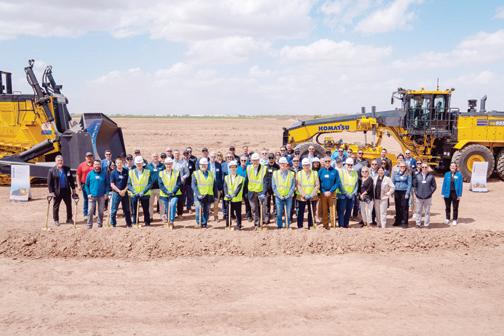
Komatsu customers, employees and local
gathered to break ground for the company’s new facility in Mesa, Ariz.
gic investments in infrastructure and world-class amenities make us a premier destination for businesses such as Komatsu to thrive and grow with our community.” The project is expected to promote significant economic benefits. In addition to creating short-term construction jobs during the building phase, Komatsu anticipates up to 100 new long-term positions within the first few years. For more information, visit komatsu.com.
Acrow, an international bridge engineering and supply company, said one of its modular steel bridges was recently installed in rural Cibola County, N.M., to replace a structure destroyed during heavy rains.
Because the bridge provides the only reliable access to a small community, re-establishing a safe route for residents, public school transport and emergency services was a priority.
Cibola County, located in the mountainous Colorado Plateau region of New Mexico, was experiencing a period of extreme drought when a particularly intense rainfall overwhelmed drainage systems and collapsed a concrete culvert bridge over the Seboyeta Creek on County Road 5 in the village of Moquino.
After the United States Army Corps of Engineers notified Acrow about the collapse, Acrow personnel traveled to the site to assess the situation, offering the modular steel 700XS bridge to Cibola County as a cost-effective permanent solution.
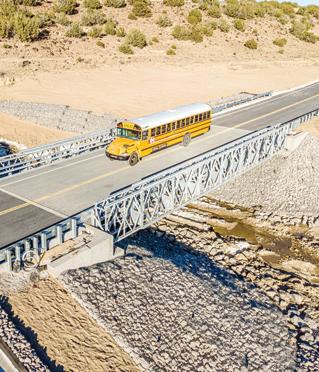
Acrow’s panel bridge was bought by the county and components of the structure arrived at the remote site in late October 2024, with assembly and installation completed by project contractor Compass Engineering & Construction Services LLC.
The bridge is 80 ft. long and has a
roadway width of 30 ft. to accommodate two lanes of traffic. It was designed to AASHTO HL-93 loading and was supplied with an epoxy-aggregate anti-skid deck and a TL-4 guardrail system.
After assembly, which was completed within a week, the bridge was installed with a crane-assisted launch. Once the approaches and other ancillary construction activities were completed, the bridge was inspected and opened to traffic.
Acrow’s modular steel bridges are hot-dip galvanized to protect against corrosion and offer a long service life with minimal maintenance, making them a dependable choice for proactive planning for future events.
“As extreme climate events increase in frequency, Acrow’s modular bridges can enable the restoration of critical bridge infrastructure quickly, safely and efficiently,” said Dan Schrager, business development manager –Southwest Region.
For details, visit acrow.com.
Buddy @ 505-900-4185
Dave @ 505-652-8832
John @ 505-617-0799
Roland @ 505-617-5345
Joe @ 575-447-2508
Next auction:

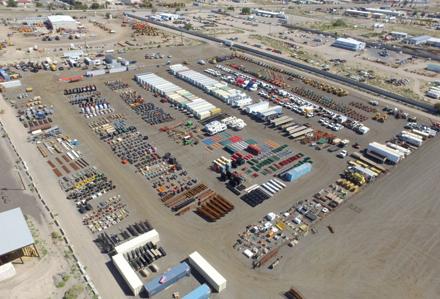
Albuquerque April 12 &13. Live onsite equipment auction featuring heavy equipment, cars, trucks, trailers, ATV's, agricultural equipment, attachments. Now Accepting Consignments.

The Steel Erectors Association of America (SEAA) announced that EZARC Building Solutions of Lindon, Utah, has joined its network of SEAA/NCCER Ironworker Training Units and Assessment Sites.
Known for its excellence in structural steel erection and fabrication and specialization in the semiconductor industry, EZARC brings unique strengths to SEAA’s training initiatives.
As one of the fastest-growing companies in Utah, EZARC Building Solutions upholds an exceptional commitment to safety, with an impressive EMR of 0.67 and a TRIR of 0.35, according to SEAA. In addition, the company is AISC Certified and woman-owned.
“Joining SEAA’s training network allows us to align our workforce development goals with industry-leading standards,” said Matt Godsey, vice president of EZARC Building Solutions. “Our core values of excellence, zero waste, accountability, resourcefulness and culture guide everything we do. Becoming a certified NCCER
Training Facility strengthens our ability to foster a highly skilled workforce while maintaining our unwavering focus on safety and quality.”
The SEAA/NCCER Ironworker Training program provides members with premier craft training options, including Ironworker Levels 1, 2, and 3; Reinforcement Ironworker Levels 1 and 2; Rigger; Signal Person; Crane Operator; and SEAA’s custom Fabricator curriculum, according to SEAA. SEAA also offers members access to its online SteelPros Training Portal, developed in partnership with Industrial Training International (ITI), which features exclusive ironworker training videos.
“SEAA’s purpose is to invest in the education of steelworkers, and partnerships like this one with EZARC Building Solutions are key to that mission,” said R. Pete Gum, SEAA’s executive director. “Their specialization in the industry and commitment to safety exemplify the standards we want to promote across the industry.”
For more information, visit seaa.net.
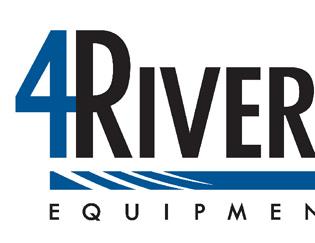





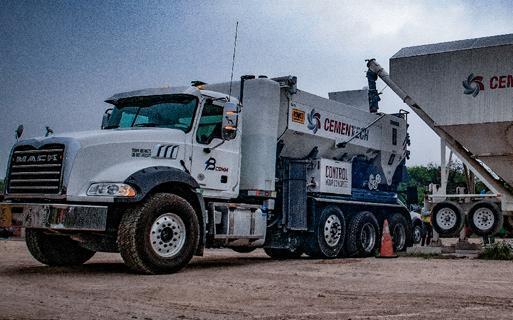



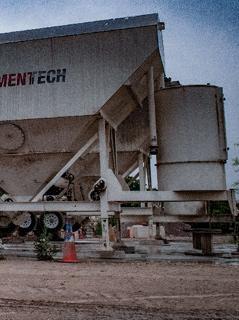































The Arizona Department of Transportation is targeting pavement improvements and expanding several key highways in the $12.7 billion Tentative Five-Year Transportation Facilities Construction Program for 2026-2030.
This list of projects ADOT intends to design and construct over the next five years is available for public comment through May 23.
The tentative five-year program provides $4.47 billion for projects throughout greater Arizona, which encompasses areas outside of Maricopa and Pima counties. Of this amount:
• $2.8 billion is planned to preserve, rehabilitate and replace pavement and bridges, including $455 million in pavement projects on interstates 8, 10, 17 and 40;
• $573 million in pavement projects on other routes, including U.S. routes 60, 70, 93, 160 and 180, and state routes 64, 72, 79, 80, 82, 85, 179, 260 and 347; and
• $237 million in bridge projects on interstates and $112 million on other routes
Another $592 million will be used for projects in greater Arizona that improve highway safety, efficiency and functionality, such as intersection improvements, updates to ports of entry and rest areas, smart technologies and adding signals, signs and shoulders.
The State Transportation Board is expected to consider formal action on the final program at its June 20 meeting.
The tentative five-year program allocates $1.05 billion for projects that widen highways or improve interchanges across Greater Arizona, including:
• $137 million to widen I-10 south of Phoenix from the Gila River Bridge to Gas Line Road;
• $110 million to widen S.R. 260 east of Payson (Lion Springs segment);
• $68 million to widen U.S. 93 north of Wickenburg (Vista Royale segment);
• $50 million to widen U.S. 93 at Big Jim Wash between Wickenburg and Wikieup;
• $66 million to replace the Colorado Bridge on I-10 at the California border, a joint project with Caltrans;
• $240 million to widen I-17 from Sunset Point to SR 69;
• $62 million for the new land port of entry road and facility in Douglas;
In Pima County, the tentative five-year program proposes $831 million in coordination with the Pima Association of Governments for projects including the following:
• $600 million for widening I-10 from Kino to Country
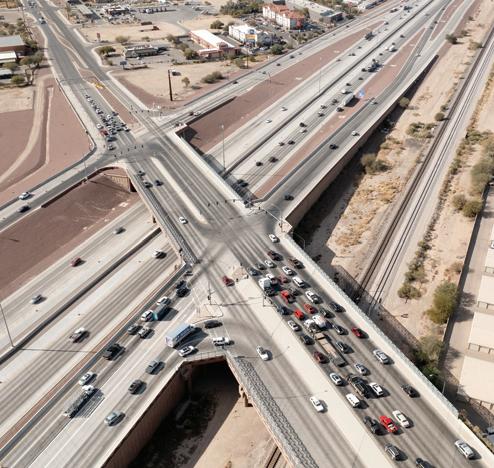
Interstate 10 would receive several upgrades from 2026-2030 as per ADOT’s five-year plan.
Club, which includes building a new interchange at I-10 and Country Club Road and reconstructing the Kino Road interchange;
• $290 million to widen I-10 from Alvernon Way to Valencia Road;
• $47 million to reconstruct the I-19 interchange at
Irvington Road; and
• $97 million to improve the interchanges on I-10 at Park and Sixth avenues
In Maricopa County, the tentative five-year program features $2.38 billion for projects planned in conjunction with the Maricopa Association of Governments (MAG). This funding will be supplemented with funds from Proposition 479, which voters approved in November, 2024
With the passage of Prop 479, MAG is now working on updating project schedules and costs for its Freeway Life Cycle Program. Those updates will be reflected in amendments to MAG’s Transportation Improvement Program update and will be subsequently incorporated into the ADOT five-year program.
The tentative five-year program includes $135 million for the Airport Capital Improvement Program, which provides funding in conjunction with the Federal Aviation Administration for projects to design and construct safety, security and capacity enhancements, prepare various plans and studies, and fund improvements at the Grand Canyon National Park Airport, which ADOT operates.
Funding for the overall statewide program comes from federal and state dollars, in addition to money generated by users of transportation services in Arizona, primarily through gasoline and diesel fuel taxes, the Arizona vehicle license tax and various aviation taxes. Both the Maricopa and Pima county regions have dedicated, voter-approved sales taxes for transportation that fund expansion projects. (All photos courtesy of Arizona Department of Transportation.)

Road widening projects are a significant part of the Arizona Department of Transportation’s tentative five-year construction program for 2026-2030,
The Aspen, Colo., City Council approved an ordinance in January introducing new rules that reduce construction and demolition (C&D) waste from city-permitted projects, according to cdrecycler.com.
The ordinance took effect in February, with full implementation expected in 2026.
The Aspen Times reported that the ordinance sets mandatory recycling and reuse standards for recoverable materials. The intent is to reduce landfill contributions and greenhouse gas emissions.
Construction projects greater than 2,000 sq. ft. are targeted, with the ordinance requiring
them to divert 100 percent of recoverable materials, including concrete, untreated lumber and metal, according to cdrecycler.com. Those projects also must meet a minimum recovery standard of 50 percent of total debris weight; contractors must submit a refundable deposit based on estimated tonnage.
The Aspen Times reported that the policy is in step with Aspen’s climate goals. Those goals call for a 63 percent reduction in greenhouse gas emissions by 2030, with full neutrality by 2050. C&D debris accounts for more than half of the material buried in the Pitkin County land-
fill, cdrecycler.com reported. Before the ordinance was passed, city employees said contractors will still see greater future expenses when the landfill becomes full. That would require longer deliveries to the nearest landfill, which is west of Glenwood Springs.
The C&D ordinance includes noncompliance penalties.
Projects that don’t separate recoverable materials face a municipal penalty of $495 per ton for unsorted loads, aside from Pitkin County’s operational tipping fee of $245 per ton, according to cdrecycler.com. The city said those fees are designed to hold violators accountable, thus reinforcing the importance of compliance. However, contractors will be granted leniency when materials are challenging to recycle because of adhesives or mixed composition.
To limit the potential impacts of longer demolition processes required for sorting through materials, the city plans to provide workforce training on separating materials and efficient deconstruction methods. In addition, it will waive some fees for compliant projects and explore long-term solutions, such as off-site sorting facilities, to ease the contractor burden, cdrecycler.com reported.
from page 1
Future phases will see the addition of a sportsplex multisport facility, a stadium, entertainment pavilion, event plaza, splashpads, three hotels, as many as 10 restaurants and a parking structure.
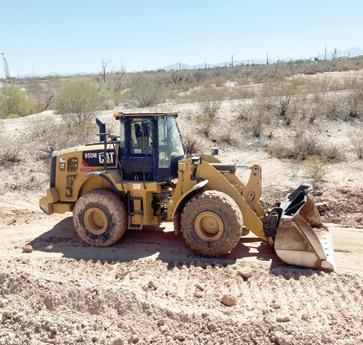
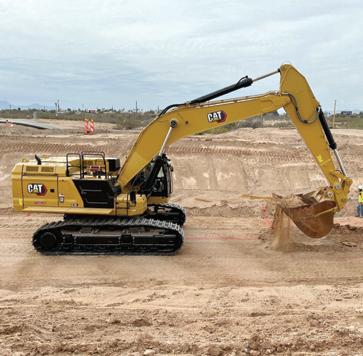
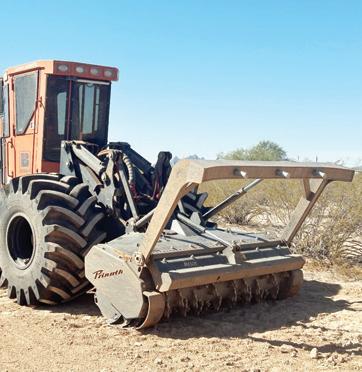
Additionally, Knott Development will build a headquarters on the property for its leaders and those of Mosaic Quarters Development and the MQ Foundation. It also will include 5,000 sq. ft. of donated space to the Pima Community College’s Culinary Arts program, which will use it to open a restaurant managed and operated by students.
Planners envision the entire project as a one-stop-shopping of sorts for local youth and adult sporting leagues, regional and national tournaments, free family-oriented entertainment, community events, and programs focusing on healthy lifestyles.
With the neighboring Kino Sports Complex, home to a dozen athletic fields and 20 lighted pickleball courts, they see the area developing into a destination spot for vacationing families and sporting enthusiasts.
Here is the complete lineup of construction equipment Granite workers are using for the Phase I buildout:
Water trucks
• Peterbilt 335 and 567
• Freightliner 4K
• Cat 631E water pull
Excavators
• Cat 330BL
• Cat 374
• Takeuchi mini-excavator
Loaders
• Cat 950M
• Cat 950GC
Scrapers
• Cat 623E X2
• Cat 623G
• Cat 631 X2
Miscellaneous
• Cat 12K telehandler
• Cat 14H grader
• Cat 140-13 grader
• Cat 150-15 grader
• Cat D10R dozer
• Cat D8T dozer
• John Deere 8340 ag tractor with TATU GASPM EHD
• Cat 420 backhoe
• Cat 360c compactor
• Hamm 84-in. padfoot roller
• Klein tank
• Barko 930B mulcher
(All photos courtesy of Granite Construction.)

5

















y ackast-tr can f tions and t solu our See how productivity technology our
